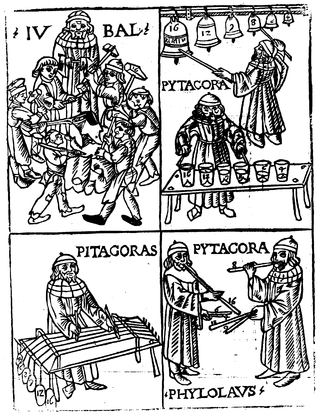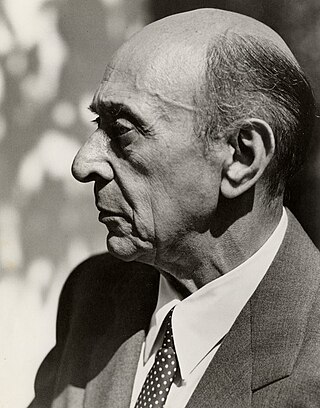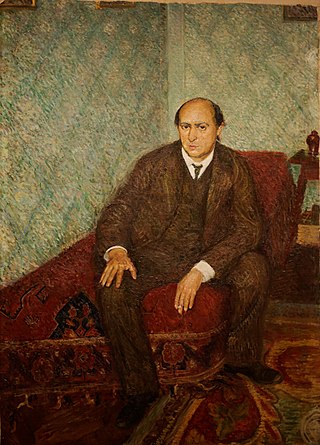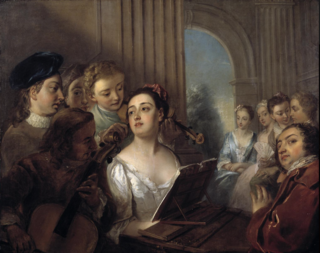Related Research Articles
In music, a tone row or note row, also series or set, is a non-repetitive ordering of a set of pitch-classes, typically of the twelve notes in musical set theory of the chromatic scale, though both larger and smaller sets are sometimes found.

Music theory is the study of the practices and possibilities of music. The Oxford Companion to Music describes three interrelated uses of the term "music theory": The first is the "rudiments", that are needed to understand music notation ; the second is learning scholars' views on music from antiquity to the present; the third is a sub-topic of musicology that "seeks to define processes and general principles in music". The musicological approach to theory differs from music analysis "in that it takes as its starting-point not the individual work or performance but the fundamental materials from which it is built."

Arnold Schoenberg or Schönberg was an Austrian-American composer, music theorist, teacher, writer, and painter. He is widely considered one of the most influential composers of the 20th century. He was associated with the expressionist movement in German poetry and art, and leader of the Second Viennese School. As a Jewish composer, Schoenberg was targeted by the Nazi Party, which labeled his works as degenerate music and forbade them from being published. He emigrated to the United States in 1933, becoming an American citizen in 1941.
In music, serialism is a method of composition using series of pitches, rhythms, dynamics, timbres or other musical elements. Serialism began primarily with Arnold Schoenberg's twelve-tone technique, though some of his contemporaries were also working to establish serialism as a form of post-tonal thinking. Twelve-tone technique orders the twelve notes of the chromatic scale, forming a row or series and providing a unifying basis for a composition's melody, harmony, structural progressions, and variations. Other types of serialism also work with sets, collections of objects, but not necessarily with fixed-order series, and extend the technique to other musical dimensions, such as duration, dynamics, and timbre.

The twelve-tone technique—also known as dodecaphony, twelve-tone serialism, and twelve-note composition—is a method of musical composition first devised by Austrian composer Josef Matthias Hauer, who published his "law of the twelve tones" in 1919. In 1923, Arnold Schoenberg (1874–1951) developed his own, better-known version of 12-tone technique, which became associated with the "Second Viennese School" composers, who were the primary users of the technique in the first decades of its existence. The technique is a means of ensuring that all 12 notes of the chromatic scale are sounded as often as one another in a piece of music while preventing the emphasis of any one note through the use of tone rows, orderings of the 12 pitch classes. All 12 notes are thus given more or less equal importance, and the music avoids being in a key. Over time, the technique increased greatly in popularity and eventually became widely influential on 20th-century composers. Many important composers who had originally not subscribed to or actively opposed the technique, such as Aaron Copland and Igor Stravinsky, eventually adopted it in their music.

Dreimal sieben Gedichte aus Albert Girauds "Pierrot lunaire", commonly known simply as Pierrot lunaire, Op. 21, is a melodrama by Arnold Schoenberg. It is a setting of 21 selected poems from Albert Giraud's cycle of the same name as translated into German by Otto Erich Hartleben. The work is written for reciter who delivers the poems in the Sprechstimme style accompanied by a small instrumental ensemble. Schoenberg had previously used a combination of spoken text with instrumental accompaniment, called "melodrama", in the summer-wind narrative of the Gurre-Lieder, which was a fashionable musical style popular at the end of the nineteenth century. Though the music is atonal, it does not employ Schoenberg's twelve-tone technique, which he did not use until 1921.

In music, a subject is the material, usually a recognizable melody, upon which part or all of a composition is based. In forms other than the fugue, this may be known as the theme.

Allen Forte was an American music theorist and musicologist. He was Battell Professor Emeritus of the Theory of Music at Yale University and specialized in 20th-century atonal music and music analysis.

Carl Dahlhaus was a German musicologist who was among the leading postwar musicologists of the mid to late 20th-century. A prolific scholar, he had broad interests though his research focused on 19th- and 20th-century classical music, both areas in which he made significant advancements. However, he remains best known in the English-speaking world for his writings on Wagner. Dahlhaus wrote on many other composers, including Josquin, Gesualdo, Bach and Schoenberg.

Verklärte Nacht, Op. 4, is a string sextet in one movement composed by Arnold Schoenberg in 1899. Composed in just three weeks, it is considered his earliest important work. It was inspired by Richard Dehmel's poem of the same name, combined with the influence of Schoenberg's strong feelings upon meeting the sister of his teacher, Alexander von Zemlinsky (1877–1923), whom he married in 1901. The movement can be divided into five distinct sections which refer to the five stanzas of Dehmel's poem; however, there are no unified criteria regarding movement separation.
David Benjamin Lewin was an American music theorist, music critic and composer. Called "the most original and far-ranging theorist of his generation", he did his most influential theoretical work on the development of transformational theory, which involves the application of mathematical group theory to music.

Drei Klavierstücke, Op. 11, is a set of pieces for solo piano written by the Austrian composer Arnold Schoenberg in 1909. They represent an early example of atonality in the composer's work.
Carlos Claudio Spies was a Chilean American composer.

Arnold Schoenberg's Suite for Piano, Op. 25, is a 12-tone piece for piano composed between 1921 and 1923. The work is the earliest in which Schoenberg employs a row of "12 tones related only to one another" in every movement: the earlier 5 Stücke, Op. 23 (1920–23) employs a 12-tone row only in the final waltz movement, and the Serenade, Op. 24, uses a single row in its central Sonnet. The basic tone row of the suite consists of the following pitches: E–F–G–D♭–G♭–E♭–A♭–D–B–C–A–B♭.
Arnold Whittall is a British musicologist and writer. He is Professor Emeritus at King's College London. Between 1975 and 1996 he was Professor at King's. Previously he lectured at Cambridge, Nottingham (1964–1969) and Cardiff (1969–1975), where one of his students was Australian composer Norma Tyer.

Realization is the art of creating music, typically an accompaniment, from a figured bass, whether by improvisation in real time, or as a detained exercise in writing. It is most commonly associated with Baroque music.

Timothy L. Jackson is an American professor of music theory who has spent most of his career at the University of North Texas and specializes in music of the eighteenth through twentieth centuries, Schenkerian theory, politics and music. He is the co-founder of the Journal of Schenkerian Studies. In 2020, he became controversial for editing a special issue of that journal containing articles criticizing Philip Ewell's plenary talk "Music Theory's White Racial Frame".
Joshua Banks Mailman is an American music theorist, as well an analyst, composer, improvisor, philosopher, critic, and technologist of music.
Anthony John Leonard Pople was a British musicologist and writer. He is known for his technological approach to musicology and music analysis. During his career, Pople held professorships at Lancaster University, University of Southampton and University of Sheffield. He also served as the editor of Music Analysis for five years.
References
- 1 2 3 4 5 6 7 8 9 Jonathan Mark Dunsby: Curriculum vitae (PDF), University of Rochester , retrieved 1 January 2021
- 1 2 3 4 5 6 7 8 9 10 11 12 13 Rosemary Williamson (2001), "Dunsby, Jonathan (Mark)", Grove Music Online , Oxford University Press, doi:10.1093/gmo/9781561592630.article.06879
- ↑ Barry Millington (21 December 2020), "Dame Fanny Waterman obituary", The Guardian , retrieved 31 December 2020
- ↑ Jonathan Dunsby; Arnold Whittall (1995), "'A Slight Oversimplification': An Interview with Arnold Whittall", Music Analysis , 14 (2/3): 131–139, doi:10.2307/854010, JSTOR 854010
- 1 2 3 4 Jonathan Dunsby, University of Rochester , retrieved 1 January 2021
- ↑ Professores Emeriti (PDF), University of Reading , retrieved 1 January 2021
- ↑ "Current Officers and Terms of Service" (PDF), MTSNYS Newsletter, Music Theory Society of New York State, 1 February 2012, retrieved 1 January 2021
- ↑ Bethany Lowe (2011), "Analysing Performances of Sibelius's Fifth Symphony: the 'One Movement or Two' Debate and the Plurality of the Music Object", Music Analysis , 30 (2/3): 218–271, doi:10.1111/j.1468-2249.2011.00308.x, JSTOR 41495901
- 1 2 3 4 Sarah Martin (1998), "Reviewed Works: Performing Music: Shared Concerns by Jonathan Dunsby; The Practice of Performance: Studies in Musical Interpretation by John Rink", Music Analysis , 17: 108–121, doi:10.2307/854375, JSTOR 854375
- ↑ Peter Johnson (1997), "Musical Works, Musical Performances", The Musical Times , 138 (1854): 4–11, doi:10.2307/1003750, JSTOR 1003750